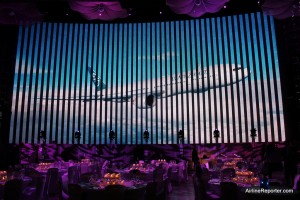
Dinner hosted at the Experience Music Project in downtown Seattle the night before the delivery.
Air New Zealand’s first Boeing 777-300ER was recently delivered to the airline, then flown to Los Angeles before heading to Auckland. Being able to show off the new interior was quite exciting. This was a huge deal for Air New Zealand, Boeing and airline geeks around the world. Boeing and Air New Zealand worked hard to make sure the hand over was not a small celebration and I wanted to share what happens behind-the-scenes on a VIP aircraft delivery.
The event really started the day before the delivery. Boeing employees, Air New Zealand guests, the media and other VIP’s were invited to take a special tour of the Boeing factory and attend a celebratory dinner. Due to scheduling I had to choose to either take a tour of the factory (which I have done quite a bit previously) or take a ride down to LAX on the new plane. Needless to say, I didn’t make the tour.
After the factory tour, people were invited to dinner, which was hosted at the Experience Music Project and Science Fiction Museum in downtown Seattle. The dinner was quite the fancy affair. “The venue – Experimental Music Project (EMP) was a good fit for the delivery dinner as it followed ANZ ‘s branding of clean, modern, sleek, technologically advanced and fun as well as all the lighting etc that are part of their new interior and product,” Linda Lee with Boeing International Communications explained to me.
Everyone was in business suits and fancy h’orderves and drinks were being served when I arrived. Although we had free access to roam the facility, I decided to stay and talk with Air New Zealand and Boeing folks. We were housed in a very large room with a huge LED wall with an Air New Zealand Boeing 777-300ER displayed on the wall. On either side was a projected Air New Zealand logo and on the other a Boeing logo. The purple hue of the lights really matched the feeling of the inside of Air New Zealand’s new 777-300ER.
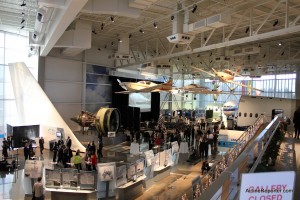
The Future of Flight’s Gallery was closed off for the delivery celebration. Where you see the projector screen were the large doors that opened to reveal the new 777-300ER (click for larger).
After things calmed down we all sat in our assigned seats. Sitting on one side of me was Andrew Baker who is the Cultural and Customer Ambassador and on the other was David Wilson who is the Boeing 777 Deputy Fleet Manager and was one of the pilots taking the new 777 to Auckland. Cool. I care very little about celebrities on TV or in movies. For me, these people are celebrities. It was wonderful speaking with them and the rest of the guests at the table about airlines, airplanes and the whole business.
Jeremy Dwyer-Lindgren of NYCAviation, who was also covering the event, pointed out that he enjoyed how Air New Zealand set up the seating. “Air New Zealand peppered in more than just the communications staff at the media tables. We had David, the first officer, and Chris, one of the premium cabin flight attendants at our table among others. To get their perspectives and pick their brains provided a much more frank and real discussion; one you may not have had at a table with only communications staff parroting talking points.” Oh yes, the food was not too shabby either.
What kind of dinner would it be with out those special speeches? There was a lot of thanks and appreciation that was shared between both companies and it was all well deserved. Although the dinner was a very fun and informational event, one couldn’t help but be excited about actually seeing the plane the next day.
Being December in Seattle, I was expecting rain. The airline-delivery gods were smiling on us and gave us one beautiful day. Our flight was scheduled to leave from Paine Field at 3pm, but were asked to show up at the Future of Flight by 10am. I really didn’t know the full plan for the day and I was totally fine with that. I knew I was there at 10am, plane was leaving at 3pm and I had my return flight back to Seattle. Everything else was going to be an adventure.
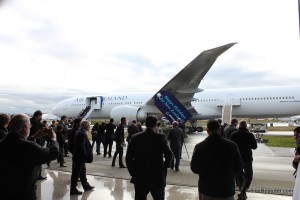
Going outside to check out Air New Zealand’s Boeing 777-300ER for the first time.
When most airplanes are delivered to an airline there isn’t a huge ceremony. On the east side of the airport, Boeing has a building where the airline’s crew will show up, some paperwork is signed and the aircraft is flown off. Actually during the ceremony, two other airlines took delivery of other Boeing 777-300ERs: Qatar and Turkish Airlines with little fanfare. But with certain milestones, airlines like to make a little bigger deal about their delivery. “Events and deliveries vary based on the airline customer i.e. Is it a first of model, milestone delivery, participation and attendance levels etc. This obviously was a large event as it was ANZ’s First 777-300ER and the world introduction of their new interior and branding,” Lee stated.
On the Future of Flight’s gallery floor there was a large stage and chairs set up. The gallery was closed to the general public during this event, but it provides one heck of a backdrop for celebrating an airplane. After some more speeches and some paperwork signed, Boeing handed over the keys — literally. Now, the keys aren’t used to actually start the plane, but I was told they do access the cockpit door. At this point, the airplane is no longer Boeing’s and belongs to the airline (well the bank I guess). After the handshakes and big smiles, the large hangar doors opened to show the shiny new Boeing 777-300ER.
Since this was a few days before Christmas (er, non-denominational holiday time-frame) there was a Santa and two elves dancing around the plane with a big sign that read “Happy Holiday Air NewZealand!” I got too caught up looking at the new plane, others caught something a bit more touching. “Another correspondent working the event noted that he saw a few welled up eyes on the team as the doors pulled back ’“ and I’m not surprised.” Dwyer-Lindgren explained to me. “To be able to share in that excitement and witness the deep pride they felt for their company and their plane was really something special.” The event was more than just getting a new airplane.
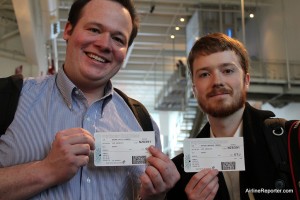
Jeremy Dwyer-Lindgren (with NYC Aviation) and I show off our boarding passes before getting on board at Paine Field.
Before any of us could take a look inside, Mr. Baker, in traditional garb, blessed the aircraft. Then it was finally time: checking out the inside. Since my blog about the interior already goes over that part of the event, I will skip it on this one. After we all had our tour, it was back into the Future of Flight’s gallery for some food and networking while we waited for the aircraft to be prepared for flight. This was a good time for most media-types to start writing out stories and checking the photos they took.
Then it was time to re-board the airplane, but in a very different way. Instead of going out the hangar doors and up onto the plane, we all went through a mini-security screening, being wanded and having our bags searched. Before getting to the security screening, we received our boarding passes. Now you know you might be an airline geek if getting a boarding pass from Paine Field to LAX gives you a huge smile. Dwyer-Lindgren explains it best, “I got the sense that all the media on board realized that this ticket was something unique and special’¦but it was us aviation nuts who appreciated it the most. To have a ticket that actually reads Paine Field’¦for a domestic flight on an international airline on a brand-spanking new 777-300ER (there are no US airlines who currently utilize them)’¦was just so unique. So yes, it was [censored] AWESOME.”
Then it was up on to the plane and time to take our seats. Let’s see, row 7, seat J, that sounds like it might be near the front of the plane and it sure was. Air New Zealand had allowed the media and their guests to try out the seats up front while they sat in Economy Plus (which weren’t too shabby either).
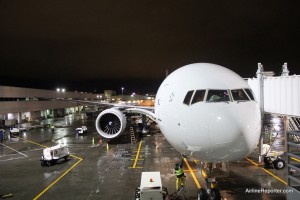
Having to leave the new Boeing 777-300ER at LAX was difficult, especially knowing she was on her way to Auckland.
Taking off in a Boeing 777-300ER, which is about 1/4 full, is a unique experience. I can tell you that we didn’t take up too much of the runway before going airborne. Being a part of a flight with only media, Boeing and airline folks is a fun ride. Easy going atmosphere, cheering during take off and great conversations. I almost wish more flying experiences could be like that.
Unfortunately the flight was short. In less than three hours we were lining up to land at LAX. For a good chunk of people on board, they were heading on to Auckland, but since it was only a few days before Christmas, I had to get off and take a flight right back to Seattle. It was not easy going from my super luxurious seat on the Air New Zealand 777-300ER to my normal economy seat heading back to Seattle.
The delivery of this aircraft was a big deal and both Boeing and Air New Zealand did it right. Although it takes a lot of work from people on both sides to make an event like this happen, it is great to remind people why they are in this business. Where most deliveries will just be pilots coming to pick up the plane with little show, others, will get a much larger and well deserved celebration.
If you missed it earlier, Air New Zealand is having a contest until Valentine’s Day to allow you to win a free trip to New Zealand or England in Cuddle Class.
A sleek powershot digital camera will take amazing photos each time you travel.
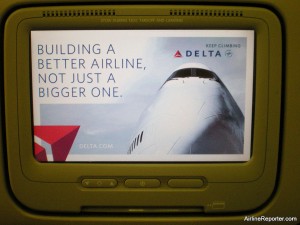
Delta ad on one of their seatback video displays.
On Monday, Delta Air Lines announced a new level of service coming to long-haul international flights: Economy Comfort. By summer 2011, more than 160 of Delta’s Boeing 747, 757, 767, 777 and Airbus A330 will have the new Economy Comfort seats installed. The seats themselves aren’t that much of a change, but what comes with them is a pretty a nice improvement. The seats will give you four more inches of legroom and 50% more recline, but you are also going to get free drinks and premium boarding.
The obvious comparison is to United Airline’s Economy Plus. United flies Economy Plus on international and domestic flights and it has been a great way to create loyalty for their passengers.
To learn more and see a great comparison chart between Economy Comfort and Economy Plus, check out Brett Snyder’s blog, Cranky Flier.For some photos and even more information, check out Dan Webb’s blog, Things in the Sky.
There is strong competition between the world’s two largest airlines and it looks like Delta has just played their hand. United… it is your move.
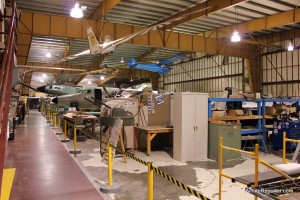
This is just one half of one of the hangars at the Museum of Flight's Restoration Center at Paine Field.
A while back I had the opportunity to check out the Museum of Flight at Boeing Field (KBFI), just south of Seattle. They have an amazing collection of aircraft and any aviation geek can find something of interest. They have vehicles on display that are covered in fabric to being found in space. Creating such an amazing collection doesn’t come easy and it takes an enormous amount of work to get old airplanes to museum quality. Where many visitors (and locals) will check out the Museum of Flight, many don’t get the whole story. A visit to check out the Museum of Flight Restoration Center, housed at Paine Field (KPAE), is a must for any aviation enthusiast.
The restoration work is mostly done by volunteers who use their time, skills and rarely even their own money to help restore the museum’s aircraft. These are people with a true passion for aviation and talking with them about their work is more exciting than viewing the actual airplanes. The facility employs only two staff, but has a roster of about 75 volunteers. The entire Aircraft Collections Department in Seattle and Everett, has a staff of three and over 125 volunteers. Volunteers will be broken up into teams and assigned to work on an aircraft. Director of Aircraft Collections and the Senior Curator will determine what needs to be done and work with the volunteers on the proper methods to do it. Since many parts can no longer be found or are too costly, in many cases, they end up making their own.
Restoring an airplane is difficult enough, but keeping it in good shape is a whole other ballgame. Most of the aircraft at the Museum of Flight and the Restoration Center are housed inside, which makes keeping them in prime condition easier. The challenge becomes the ones that live outside in the punishing Seattle weather. The Museum of Flight is in process of creating an indoor airpark to house the airliners that are outside now and the others (ie Comet, 1st 727 and Constellation) waiting to be put on display.
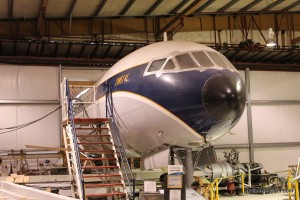
It becomes a challenging juggle between man-power, resources, money and time to keep such a large collection in pristine condition. The Restoration Center’s goal is not to get the aircraft to flying condition, but in a condition that they preserve the history of the aircraft type and of the individual plane. If the plane has damage on it, that can tell a story. They might not fully repair it since it is a part of the history of the aircraft.
Probably one of the most difficult tasks at the Museum of Flight or the Restoration Center is having to tell someone, “no,” when they have an aircraft that they want added to the collection. Boeing Field, where the Museum of Flight is located, is crowded and very expensive. Although the Restoration Center has been successfully expanding their hangar space at Paine Field throughout the years, it is becoming more difficult with the increased popularity.
Walking into the main lobby of the Restoration Center, you will find aviation related items almost everywhere. Although the lobby has some interesting things, it doesn’t compare to what you will find in the main hangar. When first entering the hangar, I had to pause and absorb everything. From old war birds, to military jets, to the front end of a Comet 4C sticking inside the hangar — I knew this was going to be a great visit. I am glad I had Tom Cathcart and TC Howard there to keep me on track or I might have just endlessly been wondering around the facility.
There are many wonderful planes with interesting stories (see all the photos), but here are three of my favorites:
THE DE HAVILLAND COMET 4C
I have seen the rear end of this plane sticking out of the hangar for many years, but had never made it inside. It is quite the site to see half the aircraft in the hangar and the rear half sticking out. This of course has caused some issues with the front being protected and the rear half being exposed to the elements. They are in the process of putting up a protective cover for the rear of the aircraft. This will make the view from outside less exciting, but it will keep the plane from deteriorating — which is well worth it.
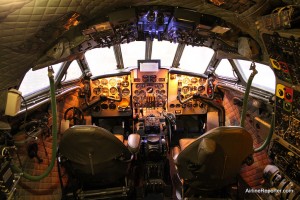
The wonderfully restored cockpit of the Comet 4C.
Stepping inside the Comet was like traveling through time. As I climbed on board, I tried to imagine what it must had been like for passengers to fly on a Comet for the first time. The Comet was the first production jet airliner and was a huge difference from their prop counterparts. What excitement passengers must have felt flying on a new generation or airliner. Yes, the Comet had some “breaking up in midair” issues at first, but by the time the Comet 4C came around, they had that sorted out.
This aircraft is being restored from the front to the back, which provides a nice insight on the process. The lavatory looked almost brand new and it was surreal seeing the photo on the wall showing what it looked like when they got the aircraft.
This exact aircraft (C/N 6424) had her first flight on October 31, 1959 and was delivered to Mexicana in July of 1960. The airplane was abandoned at Paine Field in 1979 before it was taken by Everett Community College for their students to work on. The problem was, it was a British aircraft and provided little help for American students learning how to work on American aircraft. Here is some more to explore:
* My photos of the Comet 4C during my visit
* More about the Comet 4C on the Museum of Flight’s website
* Some photos of the Comet’s restoration on Bob Bogash’s page
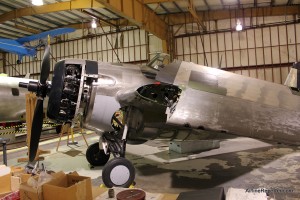
The Wildcat where you can see the new skin they put on versus the original on the wing.
THE FM-2 WILDCAT
The Wildcat is one slick plane, but I was mostly fascinated with how they have been restoring it. Like many of the other planes the Restoration Center receives, the plane wasn’t in the best of shape — it has been sitting at a park for many years. Since parts are difficult, expensive and time consuming to come by, 60% of this aircraft has been re-done in-house. You could see how some of the old skin on the aircraft remained, but much of is has been recently re-fabricated and placed on the aircraft.
On a work table there was a drawing, a paper mock up and a formed wood piece all made to re-make a part of the wing. The volunteers working there are a very creative and motivated group of people.
THE FIRST BOEING 727 (N7001U)
Ah, the first aircraft of a particular aircraft type is always a fun find. The Boeing 727-100 housed in the back of the Museum of Flight’s Restoration Center is N7001U and was the first 727 ever produced. After completing her flight testing, she served a long career with United Airlines. Unlike most other Boeing test programs, there was no dedicated test aircraft for the 727 program. The first one built was used for testing and then put into service.
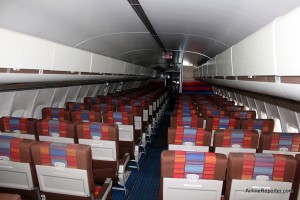
The interior of the 727 looks almost like it did when it was delivered. Can you see the obvious difference?
The plane was delivered to United on October 6, 1964 and after her long career, was delivered to the Museum of Flight in January 1991. Between that time, the aircraft flew almost 65,000 hours, made over 48,000 landings and few about 3 million passengers. The plane was configured to have the same livery and interior it had when it was first sold to United in 1964. At the time, the aircraft was gorgeous and still flight worthy. Unfortunatly United ended up removing many parts needed to keep the aircraft airborne and the Restoration Center has been working since to get this beauty back in the air.
That’s right. The goal is not to just to keep the aircraft in good shape, but also to get it where she can be flown from the Restoration Center at Paine Field, south about 30 miles to Boeing Field. It is a race against time to put new parts on the airplane while making sure it stays in good condition. In the past five years they have gotten parts donated from Clay Lacey’s old Boeing 727-200 (the cockpit is on display at the Future of Flight) and from Marcella, the Eastern Air Lines turned FedEx Boeing 727-200, whose front end is housed at the Future of Flight.
Much like walking into the Comet, the interior of the Boeing 727 takes you back in time. The colorful seats, the brown wallpaper and of course that very colorful carpet on the bulkhead. The cockpit looked like she was ready to fly and hopefully someday she might get that chance. Here is some additional information and photos of N7001U:
* My photos of N7001U inside and out
* Photos and information on the first 727 on the Museum of Flight’s site
* Additional information from Bob Bogash’s site
* Photo of the 727 in United Airline Tulip Livery
* Photo of the 727 in United Friendship Livery
The Restoration Center is not just a great place to visit, but to also learn how the restoration process works. I know many of you that read this blog have skills that could be very useful with many of their projects. If you are looking for something to do to keep you busy and you want to help out with history, the Restoration Center is always looking for dedicated people to help out. Otherwise, you are always welcome to visit (it only costs $5) to see the restoration process for yourself.
If you want more eye candy, be sure to check out the additional photos. This review will be added to my Aviation in Seattle page.
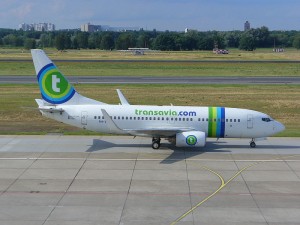
Transavia Boeing 737-700
Transavia.com is the actual name of the airline. It used to be known as just Transavia Airlines, but in 2005 they changed their name to include the “.com”. The airline was founded in 1966 and is a low cost carrier, based out of Amsterdam. It is currently owned by the AirFrance-KLM group, but operates independently.
Their fleet is made up of all Boeing 737 aircraft, with 10 -700s and 19 -800s currently in service. The airline flies flights in Europe and to Africa and Asia. The airline has two sub operations: Transavia.co France and Transavia.com Denmark, based out of Paris and Copenhagen respectively.
Their old livery was quite plain and not exciting, but I am a big fan of their current one. It is simple, yet bold. It is rare to find a livery that has a ring around the fuselage of the aircraft. I only wish they would have some color on the winglets and not just make them all white.
Image: Per aspera ad Astra











